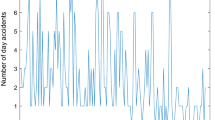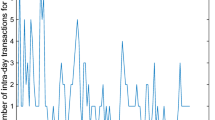Abstract
In particular, this paper addresses solutions to the computational challenges encountered in estimating parameters in non-stationary over-dispersed bivariate integer-valued autoregressive of order 1 (BINAR(1)) model with Negative Binomial (NB) innovations. In this BINAR(1) model, the cross-correlation is induced through the paired NB innovations which follows a recently introduced bivariate NB model under different over-dispersion indices. The estimation of the model parameters is conducted via a two-phased generalized quasi-likelihood (GQL) approach but the second GQLs auto-covariance structure constitutes of higher-order moment entries which are not readily available in closed form. In this context, two GQL approaches: GQL\(_{MVN}\) based on approximating the higher-order covariances through the multivariate normality structure and GQL\(_{BT}\) based on deriving the exact higher-order covariances by some novel high-dimensional thinning properties are proposed and compared. The asymptotic properties of the respective GQLs are derived. Monte-Carlo simulation experiments are implemented to investigate on the performance of the GQLs, the consistency and the asymptotic efficiency of the estimates. The proposed model and the estimation methodologies are applied to a real-life time series data in the Transport sector in Mauritius. The root mean square error based on some out-sample statistics are also computed to assess the reliability of the model.




Similar content being viewed by others
References
Agbeboh GU, Osarumwense O (2013) Empirical analysis of road traffic accidents: a case study of kogi state, north-central nigeria. Int J Phys Sci 8(40):1923–1933
Al Osh MA, Alzaid AA (1987) First-order integer-valued autoregressive process. J Time Ser Anal 8:261–275
Brijs T, Karlis D, Wets G (2008) Studying the effect of weather conditions on daily crash counts using a discrete time series model. Accid Anal Prev 40(3):1180–1190
FitzMaurice GM, Laird NM, Rotnizky AG (1993) Regression models for discrete longitudinal responses. Stat Sci 8:284–309
Jowaheer V, Sutradhar BC (2002) Analysing longitudinal count data with overdipsersion. Biometrika 89:389–399
Karlis D, Pedeli X (2013) Flexible bivariate INAR(1) processes using copulas. Commun Stat Theory Methods 42:723–740
Kocherlakota S, Kocherlakota K (2001) Regression in the bivariate Poisson distribution. Commun Stat Theory Methods 30(5):815–825
Mamode Khan NA (2016) A robust algorithm for estimating regression and dispersion parameters in non-stationary longitudinally correlated COM-Poisson. J Comput Math 19(1):25–36
Mamode Khan NA, Jowaheer V (2013) Comparing joint GQL estimation and GMM adaptive estimation in COM-Poisson longitudinal regression model. Commun Stat Simul C 42(4):755–770
Mamode Khan NA, Sunecher Y, Jowaheer V (2016) Modelling a non-stationary BINAR(1) Poisson process. J Stat Comput Simul 86:3106–3126
Marshall AW, Olkin I (1990) Multivariate distribution generated from mixtures of convolution and product families. In: Block HW, Sampson AR, Savits TH (eds) Topics in statistical dependence. Institute of Mathematical Statistics, pp 371–393
McCullagh P, Nelder JA (1999) Generalized linear models, 2nd edn. Chapman and Hall, New York, p 26
McKenzie E (1986) Autoregressive moving-average processes with negative binomial and geometric marginal distributions. Adv Appl Probab 18:679–705
Murray CJ, Lopez AD (1997) Alternative projections of mortality and disability by cause 1990–2020: global burden disease study. Lancet 349:1498–1504
Nastic AS, Laketa PN, Ristic MM (2016a) Random environment integer-valued autoregressive process. J Time Ser Anal 37(2):267–287
Nastic AS, Ristic MM, Popovic PM (2016b) Estimation in a bivariate integer-valued autoregressive process. Commun Stat Theory Methods 45(19):5660–5678
Ng CM, Ong SH, Srivastava HM (2010) A class of bivariate negative binomial distributions with different index parameters in the marginals. Appl Math Comput 217:3069–3087
Pedeli X, Karlis D (2011) A bivariate INAR(1) process with application. Stat Model Int J 11:325–349
Pedeli X, Karlis D (2013) Some properties of multivariate INAR(1) processes. Comput Stat Data Anal 67:213–225
Pedeli X, Karlis D (2009) Bivariate INAR(1) models. Technical report, Athens University of Economics
Popovic PM, Ristic MM, Nastic AS (2016) A geometric bivariate time series with different marginal parameters. Stat Pap 57:731–753
Prentice RL, Zhao LP (1991) Estimating equations for parameters in means and covariances of multivariate discrete and continuous responses. Biometrics 47:825–39
Ristic MM, Nastic AS, Jayakumar K, Bakouch HS (2012) A bivariate INAR(1) time series model with geometric marginals. Appl Math Lett 25(3):481–485
Steutel FW, Van Harn K (1979) Discrete analogues of self-decomposability and stability. Ann Probab 7:3893–3899
Sunecher Y, Mamodekhan NA, Jowaheer V (2016) Estimating the parameters of a BINMA Poisson model for a non-stationary bivariate time series. Commun Stat Simul Comput 46(9):6803–6827
Sunecher Y, Mamodekhan NA, Jowaheer V (2017) A gql estimation approach for analysing non-stationary over-dispersed BINAR(1) time series. J Stat Comput Simul 87(10):1911–1924
Sutradhar B.C (2008) Best practice recommendation for forecasting counts. Technical report, Department of Mathematics and Statistics, Memorial University of Newfoundland, Canada
Wedderburn RWM (1974) Quasi-likelihood functions, generalized linear models, and the Gauss–Newton method. Biometrika 61(3):439–47
Zheng H, Basawa I, Datta S (2007) First-order random coefficient integer-valued autoregressive processes. J Stat Plan Inference 173(1):212–229
Acknowledgements
The authors are thankful to Professor D. Karlis for his valuable suggestions. The authors acknowledge the financial grant from the Mauritius Research Council under the Unsolicited Research Grant Scheme for the project Investigating the causes of Road accidents in Mauritius using Discrete Time Series Model.
Author information
Authors and Affiliations
Corresponding author
Appendices
A
Proof of Lemma 1
\(\square \)
Derivation of serial- and cross-covariances:
and hence the lag-h serial correlation is derived as
Using the independency between the innovation terms \(R_t^{[1]}\) and \(R_t^{[2]}\) and the random variables \(Y_{t-1}^{[1]}\), \(Y_{t-1}^{[2]}\), \(\alpha _{1,t}\), \(\alpha _{2,t}\) and the counting sequences, we have that the cross-covariance between the two series is given by
At the end of this section, we derive the covariances Cov\((Y_t^{[1]}, Y_{t+h}^{[2]})\) and Cov\((Y_t^{[2]}, Y_{t+h}^{[1]})\). The first one is derived as
Similarly, we obtain that
Proof of Lemma 3
-
(a)
For given \(Y_{t-1}^{[1]}\) and \(Y_{t-1}^{[2]}\), the product \(W_{1,t}W_{2,t}\) is independent of the product \(R_{t}^{[1]}R_{t}^{[2]}\), which implies that the corresponding covariance is 0.
-
(b)
For given \(Y_{t-1}^{[1]}\) and \(Y_{t-1}^{[2]}\), the random variables \(W_{k,t}\) and \(W_{j,t}\) are mutually independent random variables independent of the random variables \(R_t^{[1]}\) and \(R_t^{[2]}\). Using this and the property of the binomial thinning operator that \(E(\alpha _{k,t}\circ Y_{t-1}^{[k]}|Y_{t-1}^{[k]})= \rho _{k} Y_{t-1}^{[k]}\), we have that
$$\begin{aligned} Cov(W_{k,t}R_t^{[j]}, W_{j,t}R_t^{[k]}|Y_{t-1}^{[1]}, Y_{t-1}^{[2]})= & {} \prod _{i=1}^2 E(W_{i,t}| Y_{t-1}^{[i]}) Cov(R_t^{[1]},R_t^{[2]})\\= & {} \nu \prod _{i=1}^2 \rho _{i} c_i \lambda _t^{[i]} Y_{t-1}^{[i]}. \end{aligned}$$ -
(c)
The proof follows from the conditional independency of the random variables \(W_{k,t}\) and \(R_t^{[1]}\) and \(R_t^{[2]}\) for given \(Y_{t-1}^{[1]}\) and \(Y_{t-1}^{[2]}\), and the fact that the covariance between the random variables \(R_t^{[j]}\) and \(R_t^{[1]} R_t^{[2]}\) is given by
$$\begin{aligned} Cov(R_t^{[j]}, R_t^{[1]} R_t^{[2]}) = \lambda _t^{[1]} \lambda _t^{[2]} (1+\nu c_1 c_2 +c_j \lambda _t^{[j]} + \nu c_1 c_2 \lambda _t^{[j]} + 2 \nu c_j^2 c_k \lambda _t^{[j]}). \end{aligned}$$ -
(d)
From the conditional independency of the random variables \(W_{1,t}\), \(W_{2,t}\) and \(R_t^{[j]}\) for given \(Y_{t-1}^{[1]}\) and \(Y_{t-1}^{[2]}\), we have first that
To derive the conditional variance \(Var(W_{k,t}|Y_{t-1}^{[k]})\), we first derive the conditional second order moment \(E(W_{k,t}^2|Y_{t-1}^{[k]})\). We have that
Using this result we obtain that the conditional variance is given by \(Var(W_{k,t}|Y_{t-1}^{[k]}) = \frac{\rho _{k}(1-\rho _{k})}{1+c_k} Y_{t-1}^{[k]} (1+c_k Y_{t-1}^{[k]})\). Replacing this result in the above expression for the conditional covariance we prove this last statement. \(\square \)
Proof of Lemma 4
Proof
-
(a)
Using the results from the previous lemma we have that
$$\begin{aligned}&Var\left( W_{k,t} R_t^{[j]}\big |Y_{t-1}^{[k]}\right) = E\left( W_{k,t}^2\big |Y_{t-1}^{[k]}\right) E\left( {R_t^{[j]}}^2\right) - \left( E(W_{k,t}\big |Y_{t-1}^{[k]}\right) E\left( {R_t^{[j]}})\right) ^2 \\&\quad = \lambda _t^{[j]} \left( 1+\lambda _t^{[j]} + c_j \lambda _t^{[j]}\right) \left[ \frac{\rho _{k}(1-\rho _{k})}{1+c_k} Y_{t-1}^{[k]} + \frac{\rho _{k}(c_k + \rho _{k})}{1+c_k} {Y_{t-1}^{[k]}}^2\right] \\&\qquad -\rho _{k}^2 {\lambda _t^{[j]}}^2 {Y_{t-1}^{[k]}}^2. \end{aligned}$$ -
(b)
This statement follows from the conditional independency of the random variables \(W_{1,t}\) and \(W_{2,t}\) for given \(Y_{t-1}^{[1]}\) and \(Y_{t-1}^{[2]}\).
-
(c)
Follows from the definition of the bivariate negative binomial distribution of Ng et al. (2010).
\(\square \)
Rights and permissions
About this article
Cite this article
Mamode Khan, N., Sunecher, Y., Jowaheer, V. et al. Investigating GQL-based inferential approaches for non-stationary BINAR(1) model under different quantum of over-dispersion with application. Comput Stat 34, 1275–1313 (2019). https://doi.org/10.1007/s00180-018-0836-5
Received:
Accepted:
Published:
Issue Date:
DOI: https://doi.org/10.1007/s00180-018-0836-5




